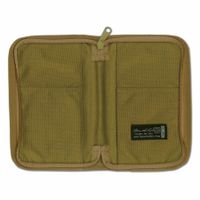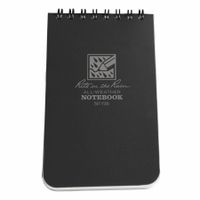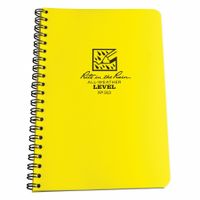Call +(254) 703 030 000 / 751 483 999 / 721 704 777
- Home
- Office Supplies
- Office Paper Notebooks
- Notebooks Notepads
- All Weather Notebooks Notepads
.....Read More
Frequently Asked Questions
What are the best all-weather notebooks for construction workers?
Rite in the Rain All-Weather Notebooks are highly recommended for construction workers. These notebooks are designed to withstand harsh weather conditions, including rain, mud, and snow. They feature a patented all-weather writing paper that repels water, allowing users to write in any weather using a pencil or an all-weather pen. The durable cover and spiral binding ensure the notebook remains intact even in rugged environments.
Field Notes Expedition Notebooks are another excellent choice. They are made with Yupo synthetic paper, which is waterproof and tear-resistant. The notebooks are compact, making them easy to carry in a pocket or tool belt. They are ideal for jotting down measurements, notes, and sketches on-site.
Moleskine Classic Notebooks with a water-resistant cover are also suitable for construction workers. While not entirely waterproof, they offer some protection against moisture and are known for their high-quality paper and durability. They are available in various sizes and formats, providing flexibility for different needs.
Elan Publishing Company Weatherproof Notebooks are budget-friendly options that offer water-resistant paper and a sturdy cover. They are spiral-bound, allowing them to lay flat for easy writing, and are available in different sizes and formats.
Lastly, the Weatherproof Top-Spiral Notebook by Portage is designed for outdoor use with a water-resistant cover and paper. It is compact and easy to carry, making it a practical choice for construction workers who need to take notes on the go.
These notebooks are designed to endure the demanding conditions of construction sites, ensuring that important information is preserved regardless of the weather.
How do all-weather notebooks resist water and other elements?
All-weather notebooks resist water and other elements primarily through the use of specialized paper and binding materials. The paper in these notebooks is typically coated with a waterproofing agent, such as a synthetic polymer or a wax-based substance, which creates a barrier that prevents water from penetrating the surface. This coating allows the paper to repel water, mud, and other liquids, ensuring that the writing remains intact even in wet conditions.
Additionally, the paper is often made from a durable, tear-resistant material, such as a synthetic fiber or a blend of cellulose and synthetic fibers, which enhances its ability to withstand harsh environmental conditions. This durability ensures that the pages do not disintegrate or become damaged when exposed to moisture, extreme temperatures, or rough handling.
The binding of all-weather notebooks is also designed to withstand the elements. Many of these notebooks use a spiral or wire binding that is resistant to rust and corrosion, ensuring that the pages remain securely attached even in humid or wet environments. Some notebooks may also feature a sewn or glued binding with waterproof adhesives to further enhance their resilience.
Covers of all-weather notebooks are typically made from robust materials like plastic, vinyl, or treated cardboard, providing additional protection against water, dirt, and physical damage. These covers help shield the pages from direct exposure to the elements, maintaining the notebook's integrity over time.
Overall, the combination of waterproof coatings, durable paper, resilient binding, and protective covers enables all-weather notebooks to effectively resist water and other environmental factors, making them ideal for use in outdoor and challenging conditions.
Can you use regular pens on all-weather notepads?
No, regular pens are not suitable for all-weather notepads. All-weather notepads are designed to withstand harsh conditions, such as rain, mud, and extreme temperatures. They typically have a special coating on the paper that repels water and prevents smudging. Regular pens, which use water-based or gel-based inks, are not effective on these surfaces because the ink can smear, wash away, or fail to adhere properly.
For all-weather notepads, it is recommended to use specialized writing instruments like all-weather pens or pencils. All-weather pens, such as those made by Rite in the Rain, use a special ink formula that can write on wet or greasy surfaces and is resistant to water and smudging. Pencils are also a reliable option because graphite is unaffected by water and can write on wet paper without issue.
In summary, to ensure legibility and durability of your notes in all-weather conditions, use pens specifically designed for such notepads or opt for pencils.
What are the top brands for all-weather writing supplies?
Rite in the Rain, Fisher Space Pen, and Sharpie are among the top brands for all-weather writing supplies.
Rite in the Rain is renowned for its weatherproof notebooks and paper products. Their products are designed to withstand rain, sweat, mud, and other challenging conditions, making them ideal for outdoor professionals and enthusiasts. The paper is specially coated to repel water, allowing for writing with pencils and certain pens even when wet.
Fisher Space Pen is famous for its pressurized ink cartridges that enable writing in extreme conditions, including underwater, in zero gravity, and at various temperatures. The pen's ability to write on wet or greasy surfaces makes it a favorite among astronauts, military personnel, and outdoor adventurers.
Sharpie offers a range of permanent markers that are water-resistant and can write on a variety of surfaces, including wet ones. Their industrial and extreme weather markers are particularly suited for outdoor use, providing durability and reliability in harsh conditions.
These brands are trusted for their durability and performance, making them top choices for all-weather writing needs.
How do pressurized pens work in extreme conditions?
Pressurized pens, such as the Fisher Space Pen, work in extreme conditions by utilizing a sealed ink cartridge filled with a thixotropic ink and pressurized with an inert gas, typically nitrogen. This design allows the pen to write in zero gravity, underwater, and in extreme temperatures ranging from -30°F to 250°F (-35°C to 120°C).
The key components include:
1. **Pressurized Cartridge**: The ink cartridge is hermetically sealed and pressurized to approximately 35 psi. This pressure forces the ink towards the ballpoint, ensuring a consistent flow regardless of the pen's orientation or external conditions.
2. **Thixotropic Ink**: The ink is a gel-like substance that becomes fluid when agitated by the movement of the ballpoint. This property prevents the ink from leaking or drying out, while also allowing it to write smoothly on various surfaces.
3. **Tungsten Carbide Ballpoint**: The ballpoint is made of durable tungsten carbide, which can withstand extreme conditions and provide a smooth writing experience. The ball rotates within a socket, picking up ink from the cartridge and transferring it to the writing surface.
4. **Durable Construction**: The pen's body is often made from robust materials like brass or stainless steel, providing durability and resistance to environmental stressors.
These features enable pressurized pens to function effectively in environments where traditional pens would fail, such as in space, underwater, or in extreme temperatures and pressures.
Are all-weather notebooks suitable for agricultural use?
Yes, all-weather notebooks are suitable for agricultural use. These notebooks are designed to withstand harsh environmental conditions, making them ideal for outdoor activities like farming. They are typically made with water-resistant or waterproof paper, allowing them to endure rain, mud, and other moisture-related challenges common in agricultural settings. This ensures that notes, records, and observations remain intact and legible, even in adverse weather.
The durability of all-weather notebooks extends beyond water resistance. They are often constructed with robust covers and bindings that can withstand rough handling, dirt, and frequent use. This makes them practical for farmers who need to carry them in fields, barns, or machinery.
Additionally, these notebooks can be used with various writing instruments, including pencils and certain pens, which are less likely to smudge or wash away when wet. This versatility is crucial for farmers who need to jot down information quickly and reliably.
In agriculture, accurate record-keeping is essential for tracking crop growth, pest management, weather patterns, and equipment maintenance. All-weather notebooks provide a reliable tool for maintaining these records in real-time, directly in the field, without the risk of losing valuable data to environmental factors.
Overall, the resilience and practicality of all-weather notebooks make them a valuable asset for agricultural professionals, ensuring that critical information is preserved and accessible regardless of weather conditions.
What sizes are available for all-weather notebooks and notepads?
All-weather notebooks and notepads are available in a variety of sizes to cater to different needs and preferences. Common sizes include:
1. **Pocket Size**: Typically around 3" x 5", these are compact and easy to carry, fitting comfortably in a pocket or small bag. Ideal for quick notes on the go.
2. **Field Size**: Approximately 4" x 6", these are slightly larger than pocket-sized, offering more writing space while still being portable. Popular among field professionals like surveyors and geologists.
3. **Memo Size**: Usually 3" x 5" or 3.5" x 5.5", these are similar to pocket-sized but may offer different binding or cover options.
4. **Steno Size**: Around 6" x 9", these are larger and often used for more detailed note-taking, suitable for office or fieldwork where more space is needed.
5. **A5 Size**: Approximately 5.8" x 8.3", these are popular for general use, offering a balance between portability and ample writing space.
6. **A4 Size**: About 8.3" x 11.7", these are larger and often used for extensive note-taking or documentation, suitable for desk use or carrying in a larger bag.
7. **Legal Size**: Typically 8.5" x 14", these are used for legal or professional settings where longer notes or documents are required.
8. **Custom Sizes**: Some manufacturers offer custom sizes to meet specific needs or preferences.
These notebooks and notepads often come with various binding options like spiral, stapled, or perfect bound, and may feature different page layouts such as lined, grid, or blank. The choice of size often depends on the intended use, portability requirements, and personal preference.



